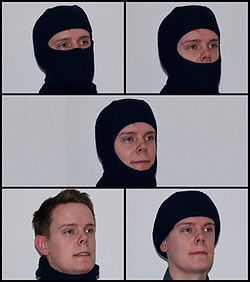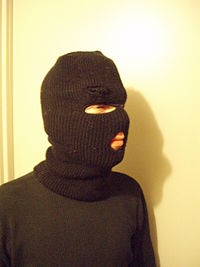- Balaclava (clothing)
-
 An example of a Provisional IRA active service unit wearing balaclavas at a 2009 Hunger Strike commemoration in Galbally, County Tyrone
An example of a Provisional IRA active service unit wearing balaclavas at a 2009 Hunger Strike commemoration in Galbally, County Tyrone
A balaclava (
 /ˌbæləˈklɑːvə/), also known as a balaclava helmet or ski mask, is a form of cloth headgear that covers the whole head, exposing only part of the face. Often only the eyes or eyes and mouth are left exposed. The name "balaclava" comes from the town of Balaklava, near Sevastopol in Crimea, Ukraine.[1]
/ˌbæləˈklɑːvə/), also known as a balaclava helmet or ski mask, is a form of cloth headgear that covers the whole head, exposing only part of the face. Often only the eyes or eyes and mouth are left exposed. The name "balaclava" comes from the town of Balaklava, near Sevastopol in Crimea, Ukraine.[1]Contents
History
During the Crimean War, knitted balaclavas were sent over to the British troops to help protect them from the bitter cold weather. However, according to Richard Rutt in his History of Handknitting, the name "balaclava helmet" did not first appear in print during the Crimean War, but only much later, in 1881.[2] This type of headgear was also known in the 19th century as an Uhlan cap or a Templar cap.[2] In modern American English, when made for those serving in the armed forces, they are usually known as "helmet liners".[3] They are traditionally knitted from wool, and can be rolled up into a hat to cover just the crown of the head, or folded right down as a collar around the neck.
Materials used
Modern balaclavas can be made from a number of materials, such as silk, cotton, polypropylene, neoprene, wool, acrylic, woollen or polar fleece.
Health and safety uses
Modern balaclavas are used in outdoor winter sports activities such as skiing, snowboarding, snowmobiling, running or winter bicycling to help protect the face from the cold wind and maintain warmth.
Motorcyclists also wear one under their safety helmets for similar reasons; balaclavas also help to keep the inner lining of the helmet clean.
Most commonly firefighters will wear a fire resistant balaclava, otherwise known as a Nomex Hood, when responding to a fire call along with their SCBA and Bunker Gear. This balaclava covers the head and neck, with an open face; typically covered by the mask portion of the SCBA. This is used to help minimize the risk of potentially fatal burns to the upper back, neck, scalp and face.
Racing drivers must[4] wear balaclavas made of fire-retardant material underneath their crash helmets in order to improve protection in case of a fire following an accident, and commonly cover the nose and mouth to reduce inhalation of smoke and fumes. Dragster-racing drivers usually wear balaclavas which have just two separate eye holes because of the increased fire risk.[citation needed]
Military and police uses
In the Indian subcontinent, balaclavas are commonly referred to as monkey caps, due to their typical earth tone colours, and the fact that they blot out most human facial features. Monkey caps sometimes have a small, decorative, woollen pom-pon on top. They are commonly worn by troops on Himalayan duty for protection from the cold.[5]
The United States Marine Corps has recently begun issuing balaclavas with hinged face guards as part of the Flame Resistant Organizational Gear program.[6][7]
Armed Russian police commonly conduct raids and searches of white-collar premises (typically in Moscow) while wearing balaclavas. Such raids have therefore come to be known in Russia as "maski shows", an allusion to popular comic TV show of the 1990s.[8]
Controversy and concealment
British Police in Kent confiscated the War on Terror board game partly due to the inclusion of a balaclava. Police said it "could be used to conceal someone's identity or could be used in the course of a criminal act".[9]
A balaclava may also be used for concealment purposes, in the course of illegal activities by criminals, and occupationally by SWAT and Special Forces personnel. It may also be used by irregular military forces or paramilitary organizations to conceal their identities.
See also
References
- ^ Games, Alex (2007). Balderdash & piffle : one sandwich short of a dog's dinner. London: BBC. ISBN 9781846072352.
- ^ a b Richard Rutt, A History of Handknitting, London 1987, pages 134-5. (Note that there is a misprint in the date of the Battle of Balaclava, which took place 1854, in the original edition cited here)
- ^ For example, here: http://knitting.about.com/od/hatpatterns/a/helmetliner.htm
- ^ In racing events, hill-climbs, special stages of rallies and selective sections of cross-country events entered on the International Sporting Calendar, all drivers and co-drivers must wear overalls as well as gloves (optional for co-drivers), long underwear, a balaclava, socks and shoes homologated to the FIA 8856-2000 standard.- http://argent.fia.com/web/fia-public.nsf/4C1C7A762BC27980C12575B700525253/$FILE/Annexe%20L_2009_15.05.09.pdf
- ^ Ghosh, Subir (2005) "Thanda lege jabey" Article in 19 Nov Hindusthan Times
- ^ http://www.marcorsyscom.usmc.mil/sites/pmice/News/Clothing/Fire-safe%20fabrics_Sep%202006.pdf
- ^ http://www.marcorsyscom.usmc.mil/sites/pmice/InfoPapers/Clothing/FROG.pdf
- ^ Kramer, Andrew E. (2011-08-31). "Memo to Exxon: Business With Russia May Involve Guns and Balaclavas". The New York Times. http://www.nytimes.com/2011/09/01/business/global/bp-russia.html?nl=afternoonupdate&emc=aua22.
- ^ "Latest news from Cambridge & Cambridgeshire. Cambridge sports, Cambridge jobs & Cambridge business - War On Terror board game seized by police". Cambridge-news.co.uk. http://www.cambridge-news.co.uk/cn_news_home/DisplayArticle.asp?ID=338658. Retrieved 2009-07-15.
Categories:- Headgear
- Hiking apparel
- Masks
Wikimedia Foundation. 2010.


